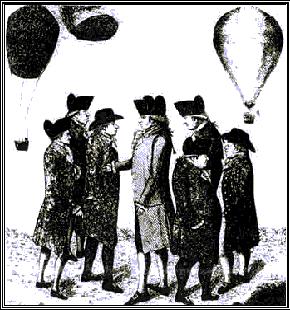THE GRAND EDINBURGH
FIRE BALLOON
James "Balloon" Tytler was a spectacular Jack-of-all-trades - surgeon, writer, publisher, composer, and poet - but his claim to fame is rooted firmly in the day he made aviation history. The "Grand Edinburgh Fire Balloon", which he invented, created a great deal of excitement in 1784 and ultimately resulted in Britain's first manned aerial ascent.
Tytler was an eccentric and luckless character, described by Burns as an "obscure, tippling though extraordinary body", and both his epic flight and his other great achievement - the eight years he spent compiling the 10-volume second edition of the Encyclopaedia Britannica - are both largely overlooked.
He worked as a surgeon and an apothecary, wrote numerous books and articles, published periodicals and a newspaper, invented a printing machine and a process for bleaching linen, and composed songs, poems and tunes for the bagpipes. None of these activities made much money - he was paid a pittance of 16/- a week for writing the Encyclopaedia - although a number of them made money for others, and he was outlawed as a debtor at least twice.
The successful flights of the Montgolfier brothers in France, in 1783, fired Tytler with an enthusiasm for ballooning and in June 1784; he exhibited the "Grand Edinburgh Fire Balloon" in the uncompleted dome of Robert Adam's Register House. The 'Fire Balloon' was barrel-shaped, 40 feet high and 30 feet in diameter, and powered by heating the air in the balloon with a stove.
Weather conditions prevented the first attempt at a flight early in August but on August 27, in Comely Gardens, an open area north-east of Holyrood in Edinburgh, Tytler tried again. Wearing only a cork jacket for protection, he seated himself in a small wicker packing case tied to the base of the balloon. When the ropes holding the balloon were released, it soared to 350 feet, travelled half a mile, and landed in Restalrig village. Tytler found the flight " most agreeable with no giddiness" and he "amused himself by looking at the spectators below".
This first flight was made in front of a small number of people early in the morning, but news of his success ensured that the next appearance of the "Fire Balloon" four days later was a major public event. A large paying audience gathered in the Comely Gardens, and the slopes of Arthur's Seat and Calton Hill were crowded with people eager to witness this historic occasion. At 2 pm, the balloon was inflated for half and hour and, with Tytler again in the basket, rose to 100 feet, sailed over the pavilion and descended gradually on the other side. This "leap" was not particularly remarkable but the spectators were delighted. However, all subsequent exhibitions of the "Grand Edinburgh Fire Balloon" were disasters. One newspaper considered that enough time had been "trifled away on this misshapen smoke-bag" and in the excitement of the flamboyant Vincenzo Lunardi's very successful balloon ascents in 1785 the unfortunate James "Balloon" Tytler was forgotten.
In 1792, Tytler fled Edinburgh for Ireland, after being arrested for producing anti-government pamphlets, and three years later he emigrated to Salem, Massachusetts. There, on a stormy night in January 1804, the first British aviator drowned whilst walking home.

"FOWLS OF A FEATHER FLOCK TOGETHER" BY EDINBURGH CARICATURIST JOHN KAY IN WHICH JAMES TYTLER AND VINCENZO LUNARDI ARE ABOUT TO SHAKE HANDS, TYTLER IS TO THE LEFT OF CENTRE. |



